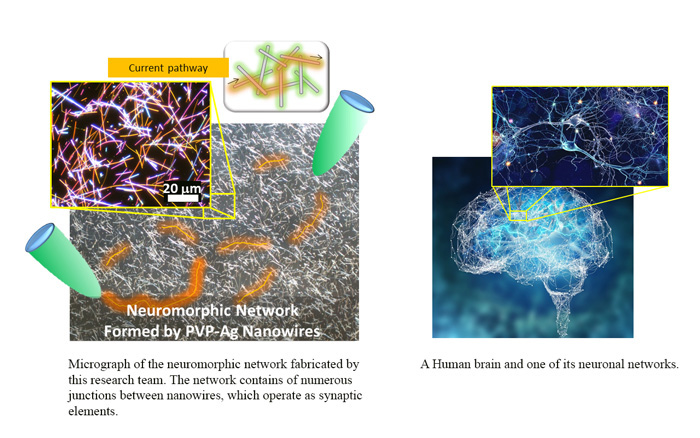- Home
- > Research
- > Research Highlights
- > Vol. 56 How Do Neuromorphic Nanowire N・・・
 Research Highlights
Research Highlights
[Vol. 56]
How Do Neuromorphic Nanowire Networks Find Routes to Convey Signals?
Researchers at MANA have investigated the dynamical behavior of neuromorphic systems made of memristive nano-switches connected together forming complex networks. They have shown experimentally the interplay between network topology and memristor dynamics giving rise to self-organized states.

In self-assembled networks of polymer-coated silver nanowires, the junction between two connected nanowires acts as a memristive switch. Upon application of current-voltage cycles it is seen that the network as a whole also behaves as a memristor, showing critical activation. However, when transient signals are applied to the network, random events produced by the breakage of individual junctions could affect the conduction properties of the whole network.
Thousands of memristive junctions interact when electrical current is passing through, dynamically routing current through the network as switching events occur between individual nanowires. This complex dynamical landscape has been sorted out by devising an original measurement scheme in which both the static and dynamic properties of the network are systematically distinguished. It has been shown that the critical activation that is characterized by a sudden increase in conductance through networks is accompanied by a change in the power-law collective dynamics. The MANA researchers discovered that an activated network finds a route to convey current in a self-organized manner, but sudden bursts of reorganization events occur whenever individual junctions fail, and the network finds other pathways, thus self-repairing.
This emergent and collective behavior provides a promising venue not only to understand better the collective dynamics of other complex systems, i.e., the brains, but also to explore new strategies for hardware integration of these networks as unconventional computing devices with the capability to perform machine learning tasks.
This research was carried out by Tomonobu Nakayama (Deputy Director, MANA Principal Investigator (PI), MANA, NIMS) and his team.
Reference
"Emergent dynamics of neuromorphic nanowire networks"
Adrian Diaz-Alvarez, Rintaro Higuchi, Paula Sanz-Leon, Ido Marcus, Yoshitaka Shingaya, Adam Z. Stieg, James K. Gimzewski, Zdenka Kuncic, and Tomonobu Nakayama
Journal : Scientific Reports [October 17, 2019]
DOI : 10.1038/s41598-019-51330-6
(Press release on this research)
" Brain-like Functions Emerging in a Metallic Nanowire Network" (11 November 2019)
https://www.nims.go.jp/mana/news_room/press/2019111101.html
(MANA E-BULLETIN)
https://www.nims.go.jp/mana/ebulletin/
Adrian Diaz-Alvarez, Rintaro Higuchi, Paula Sanz-Leon, Ido Marcus, Yoshitaka Shingaya, Adam Z. Stieg, James K. Gimzewski, Zdenka Kuncic, and Tomonobu Nakayama
Journal : Scientific Reports [October 17, 2019]
DOI : 10.1038/s41598-019-51330-6
(Press release on this research)
" Brain-like Functions Emerging in a Metallic Nanowire Network" (11 November 2019)
https://www.nims.go.jp/mana/news_room/press/2019111101.html
(MANA E-BULLETIN)
https://www.nims.go.jp/mana/ebulletin/
Affiliations
International Center for Materials Nanoarchitectonics (WPI-MANA), National Institute for Materials Science (NIMS), Namiki 1-1, Tsukuba, Ibaraki 305-0044, Japan
Contact information
Research Center for Materials Nanoarchitectonics (MANA)
National Institute for Materials Science
1-1 Namiki, Tsukuba, Ibaraki 305-0044 Japan
Phone: +81-29-860-4710
E-mail: mana-pr[AT]nims.go.jp
1-1 Namiki, Tsukuba, Ibaraki 305-0044 Japan
Phone: +81-29-860-4710
E-mail: mana-pr[AT]nims.go.jp

